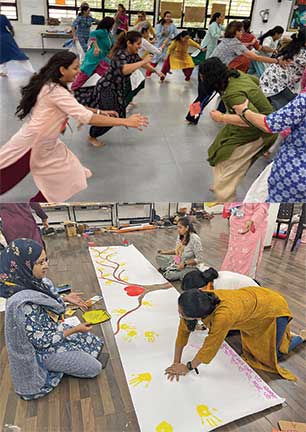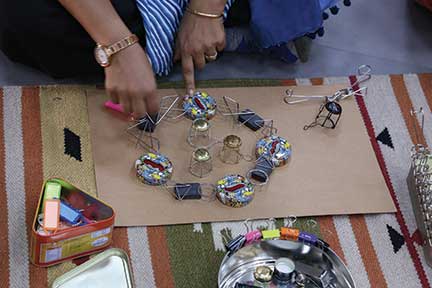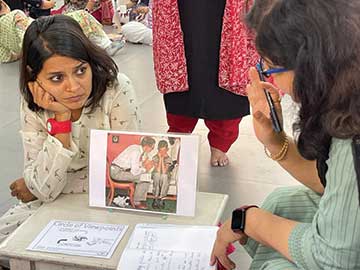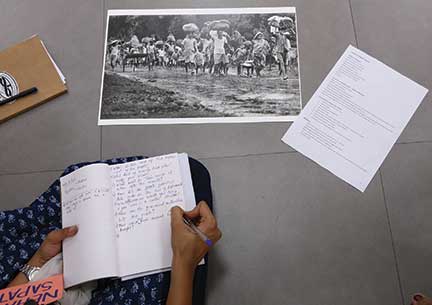Timira
Every once in a while, a momentary break in hierarchy between the teacher and the student becomes necessary. Questions that a child would never ask a teacher otherwise are posed in such moments. On one such afternoon, while sitting on the floor eating lunch with a few students, two boys from class 6 hesitantly asked me, “Ms. Timira, do you know what noble gases are?” I broke into a gentle sweat (surfacing from childhood chemistry trauma!) and with much humility replied, “Nope, don’t think I know.” The two overjoyed boys exchanged high-fives, picked up their dabbas and trotted off. Taken by surprise, I called out to them and asked, “So…what are noble gases?” “We don’t know,” they replied. “We saw it in our chemistry textbook. You’re the head of the school, so we wanted to check if you know everything that we learn,” the boys laughed and ran off to the playground.

Their response left me wondering about the meaning of learning. The boys were not curious to know about noble gases, but wanted to know who knew how much about it. Our education system equates knowledge gathering to learning. It prioritizes collection and memorization of information over curiosity and comprehension. In addition, there is systematized reverence given to the holder of knowledge. The top of that hierarchy is the principal or head of school, next the teacher, then the students who get good grades and at the bottom, those who don’t score well. The idea of learning disappears somewhere. Why? Because education as a ‘system’ needs to have measurable outcomes. Knowledge is measurable, learning is not.
I would like to explore how we can reintroduce ‘learning’ into our classrooms, within the limitations of our education system. In this article, I will be relooking at the ‘learning objectives’ we set out with and try to work with the intention to explore instead of the need to measure.
In my previous article Teachers as Artists (October 2023). I wrote about moving away from ‘dull or default pedagogy’ which focusses on knowledge gathering and relies on textbook-based learning, thinly presented material and right and wrong answers. A pedagogy where there is no desire to learn more, dig deeper, and be challenged. This default approach is created from the need to have measurable outcomes and teachers can break free from this default by looking at their teaching as a creative practice, in which they design learning journeys for the students. When teachers themselves begin to see value in the process of learning, it will find its way into the learning journeys they plan for their students.
While ongoing trainings and workshops that offer arts-based experiences act like a reservoir of stimulus for a teacher to tap into, I have been exploring more structured approaches to planning ‘lessons’ that will support educators to break the default pedagogy. My first move towards breaking this is to replace the word ‘lesson’ with the term ‘learning engagement’. Changing vocabulary is an important step in changing outlook. With the advent of this term, we break the default by relooking at the teachers as creative practitioners who engage with new ideas, search for inspiration around them and look inward to find answers and new methods of engaging with learning. They are not just individuals teaching a lesson!
Learning experiences, as the term suggests, is a more expansive understanding of what we are expected to learn. It includes exploration, discovery, discussion, debate, research and documentation amidst other endeavours, all of which aid learning.
“The idea of learning disappears somewhere. Why? Because education as a ‘system’ needs to have measurable outcomes. Knowledge is measurable, learning is not.”

Layering objectives
Every learning engagement has an objective. In fact, it has multifold objectives, which can be layered with intention by its creator, the teacher. However, most learning objectives in default lesson plans are academic in nature, focused on content and syllabus. These objectives must be observable, measurable, and specific to what the learner will be ‘doing’ in that particular class. For instance, class 1 students must be able to classify plants in the five categories of trees, shrubs, herbs, climbers, and creepers when shown actual plants or images of them is a typical learning objective which is specifically cognitive in nature. If there is an aspect of drawing or writing, it extends to psychomotor objectives and with group work or presentations added, the learning objective may include, though rarely, aspects from social domains.
Once again, I encourage us to move away from this default format. I’d like to share an approach I have been working on with several groups of teachers, which offers a broad framework to be able to design a learning experience using various objectives, skills, tools and techniques after careful consideration and fair bit of research, creative thinking, and play. I like to call this the ‘layering’ approach, in which several objectives are laid down at the start and the teacher picks and chooses various combinations of these objectives as the learner journeys ahead.
Layer 1 – The academic objective
We begin with the given academic objective that comes from the syllabus as we cannot dismiss it. This will typically require students to identify, label, recall, describe, explain, define, classify, summarize… you get the point.
Eg: For this layering exercise, let’s take the above example of class 1 students classifying plants.
Layer 2 – Skill and social objective
Skill objective may entail introducing various study skills and learning tools like note-making, tabular formats, mind maps, flowcharts, or simply motor skills and life skills like cutting, drawing, pasting, creating visual displays, diagram making, etc. Social objectives would be to create opportunities to engage in groups, pairs, present, take interviews, conduct surveys, etc.
Eg: Taking the example ahead, students in groups of four, can be asked to look at 10 images of plants, discuss which plants are similar and group them.

Layer 3 – The thinking objective
This objective focuses on deeper thinking. Teachers can use a variety of tools available for higher order thinking or deeper thinking like Bloom’s Taxonomy or Project Zero’s Thinking Routines and add it as a layer to any part of this learning engagement. With continuous use of such routines and tools, it eventually becomes second nature for teachers to ask better questions and for students to think deeper.
Eg: Students can use the Thinking Routine ‘See-Think-Wonder’ while looking at the images of the plants. Or use the routine of ‘Claim-Support-Question’ in which the group makes a claim, uses evidence to support the claim and poses questions that they may have.
“My first move towards breaking ‘default pedagogy’ is to replace the word ‘lesson’ with the term ‘learning engagement’. Changing vocabulary is an important step in changing outlook.”
Layer 4 – The artful objective
This is my favourite! This is an objective that draws inspiration from the arts. It is vocabulary that is found when a teacher is immersed in an artistic experience. Here is some vocabulary that was recently extracted from a group of teachers who went through an artistic engagement – a sense of freedom, the feeling of being supported, feeling playful, challenged, motivated, confident. A teacher can layer an existing learning engagement with any one of these experiences to create an artful objective. This is where the teacher’s creative thinking and playfulness comes in!
Eg: Let’s take ‘feeling challenged’ as the artful objective here. Students can look for at least two plants in each category in and around their neighbourhood and try to collect leaves from these plants along with finding out their names. Another example, if the teacher would like their students to ‘feel playful’, they can indulge in a quick game of making trees with their bodies in groups using all the characteristics they have learnt, while other groups guess which trees they have made! This will push students to make appropriate choices while feeling playful.

Layer 5 – The teacher objective
This objective is nuanced and comes from the selfhood of the teacher, from the interests, deepest passions, and worldview that the teacher holds on to and lives by. However, the teacher must be very mindful not to bring in their personal prejudice here but use it to foster discussions and conversations, always holding a position of neutrality.
A teacher may feel strongly about the environment or animal rights, gender inclusivity or human rights or can feel deeply passionate about books, films, travel, photography, black holes, and a myriad other things. This objective encourages the teacher to bring in their personal passion and interests into the classroom with a genuine intention to share their world with their students.
Eg: Instead of taking prints of tree images, a teacher who loves books or photography can use their own resources as part of the stimulus for the class activity. A teacher who recently watched a wonderful documentary film can show a clip from the film to her students and follow it up with a thinking routine to begin discussions and ignite curiosities in the class. A teacher passionate about the environment can share an article about mowing down a forest to build a metro, as opposed to covering content from the textbook that tells us the ‘importance of trees.’
Layers 4 and 5 bring the outside world into the classroom. They bring in the humane in learning processes that can otherwise be very cold. It ensures learners are provoked or inspired or ‘feel’ something. I remember Ms. C, a geography teacher, and an absolute foodie, bringing food in every geography class. She discussed crops growing in Maharashtra by having all her students eat thaalipeeth (a flatbread made of millets, grains, and pulses) with loncha (pickle). She pulled out a menu card of a typical Maharastrian restaurant to read the names of typical dishes in the region and made her students research what ingredients were used in making them. Her students not only learnt the names of various crops that grew there, but also understood how important it was for dry states like Maharashtra to go back to eating millets which grow aplenty in arid climates.
Ms. T, another geography teacher, while exploring the Rann of Kutch and discussing salt, brought in stories from the Dandi March to show the sheer importance of salt as a basic right but also brought in news articles on how the rights of salt workers on the coast of Tamil Nadu were dismissed as they continued working in terrible conditions with measly wages today.
I have had the privilege of witnessing classrooms transform from cold, information-laden spaces to rooms full of rich discussions. It is the nature of learning to make connections across space, time, and context in a way that it brings the outside world inside the classroom, enabling, encouraging and provoking thought. Educators who use this structure and play with layering their objectives, find great satisfaction and autonomy in their teaching practice and a real sense of freedom from the constraints of the default. Now that you have this framework, I invite you to try it!
The author is an arts-based therapist, educator and children’s author. She is the former Executive Director of Akshara High School, Mumbai and has been working in the field of education for the past 15 years designing arts-based curriculum and training teachers. She can be reached at TeachersAsArtistsCollective@gmail.com.
